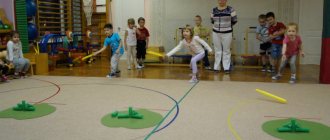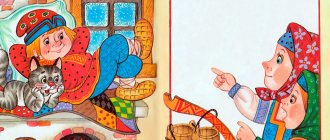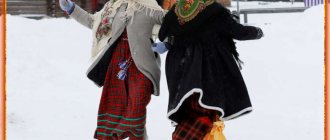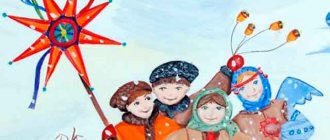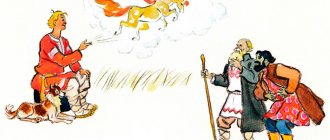Author: Fefilova Nadezhda Nikolaevna, teacher
Institution: MBOU "Dolmatovskaya Secondary School No. 6", structural unit Kindergarten No. 57 "Solnyshko" Locality: Arkhangelsk region, Velsky district, Dolmatovo village
Goal: to contribute to the creation of a joyful mood from participation in Russian folk games and amusements. Tasks:
Educational: Continue to introduce children to Russian folk games and amusements; Introduce children to folk art and Russian culture. Developmental: Promote children's health through performing various types of game tasks; Develop basic physical qualities: speed, agility, coordination of movements; Develop a sense of humor, ingenuity, and imagination. Educators: Cultivate interest in Russian folk games and amusements, the desire to play them independently; Cultivate moral and volitional qualities: endurance, a sense of responsibility to your team. Form friendly relationships, a sense of teamwork.
Progress of the entertainment: A phone rings in the group, the teacher picks up the phone and talks.
The teacher turns to the children and says that grandma Nastasya called. She is knitting socks for her grandchildren, but she has run out of thread. Grandma Nastasya really asks us to come visit her and bring some thread. Educator: Children, let’s help Nastasya’s grandmother, take her some threads for her socks? Children: Yes. Educator: Get into pairs and let’s go visit Nastasya’s grandmother. The children and the teacher go to the music room. The hall is decorated in the style of a Russian hut, the children are greeted by Grandma Nastasya (the teacher dressed in a Russian folk costume) Grandma Nastasya: Hello, kids (bows) I am Grandma Nastasya. There are so many of you, how good it is that you came to visit! I’m drinking tea and waiting for guests.
The children greet Grandma Nastasya and also bow to her.
Grandmother Nastasya: Children, do you know why the guest entered the hut with a bow? Educator: By bowing, people express their respect for their owners. Grandmother Nastasya: That's right, in the huts they even made the doors low, when you enter the hut, whether you want it or not, you will definitely bow to the owner! If a belated traveler came in, he was greeted with a bow and said, “You are welcome.” And if a guest came in during dinner, he was told: “Welcome to have some bread and salt.” Educator: What did grandma Nastasya treat the guests with? Grandmother Nastasya: Everything that is in the house, usually tea with pies or pancakes. Oh, I’ve been keeping you on the threshold for a long time, come in, make yourself at home. I was really looking forward to your visit, I put things in order in the hut, swept the floor, and as they said in the old days, “The hut is not red in its corners, but red in its pies,” so I kneaded the dough, but didn’t have time to light the oven and bake it. You need to bring in more wood to light the stove. Will you help me bring wood to the stove? (Children answer.)
The game “Bring the Firewood” is being played (children line up in two teams, whose team will bring the firewood faster) Grandmother Nastasya: They brought the firewood, now the oven will be lit and the pies will be baked. And while the pies are baking, I’ll tell you how in the old days there was a custom in Rus': how they finished their work, whiled away the evenings together: they organized gatherings to look at people and show themselves off. Some knit, some embroider, some sew, and the youth sing and dance, and play all sorts of games. It was fun. Grandma Nastasya sighs heavily and lowers her head. Educator: Grandma Nastasya, what happened, why are you so sad? Grandmother Nastasya: I was going to knit socks for my dear grandchildren, but I ran out of yarn, what should I do? Educator: Don’t worry, Grandma Nastasya, the children and I brought you some strings. Look how beautiful the balls are - blue and red. Do you like it? It’s not for nothing that in the old days they said: “If you’re going to visit, bring a gift in handfuls.” Grandma Nastasya: Thank you, my dears, I’m very glad that I can knit beautiful socks for my grandchildren as a gift. In the meantime, I invite you to play with my beautiful balls! And now we will be convinced of skill and dexterity, because you don’t learn from childhood, you suffer all your life. Come out, show your skills, when the music starts playing, you need to wind a thread into a ball. And when the music stops playing, that means you’ll have to stop winding the thread. Is the task clear? Let's start the competition
Game "Tangles"
Grandma Nastasya: My dears! How much fun it is with you! The children sit on the chairs, the teacher walks around Grandma Nastasya in a circle, admiring her scarf. Educator: Grandma Nastasya, what a beautiful scarf you have. Grandmother Nastasya: In the old days, all women in Rus' wore headscarves. They were either simply thrown over the head or shoulders, or tied in a knot under the chin. In ancient times, peasants wove scarves at home, on homemade looms, and decorated them with embroidery and ribbons. Women took care of their scarves so as not to spoil them; they were never even washed. And to keep the scarf clean, it was simply aired out. Educator: Children, do you know that in Rus' a scarf was used not only as a headdress, but they also danced in circles with scarves and played various games. The scarf was hung on a pole or rope; it could only be retrieved by jumping. The handkerchief was raised high. The winner was the one who jumped the highest and took out the scarf. Grandmother Nastasya: And I know one such Russian folk game. And it’s called “Burners with a handkerchief.” Children, do you want to play this game with me? Children: Yes.
Game "Burners with a handkerchief"
Children stand in pairs one after another and hold hands. The driver is in front, holding a handkerchief in his hand above his head. Everyone says the words in chorus: Burn, burn clearly, so that it doesn’t go out. Look at the sky, Birds are flying, Bells are ringing! One, two, three - run! The children of the last pair run along the column (one on the right, the other on the left). The one who reaches the driver first takes a handkerchief from him and stands with it in front of the column, and the latecomer “burns,” that is, leads. Educator: Grandma Nastasya, the children and I would really like to play with your big scarf. Do you know the game with the big scarf? Grandmother Nastasya: Of course, I know.
Game “One, two, three, who’s hiding inside?”
Grandmother Nastasya: Here is a painted handkerchief, it is magical, not simple. I will play with you, cover everyone with a handkerchief. Children run to the music. When the music stops, everyone should squat down and close their eyes. The teacher covers someone with a scarf and says, “One, two, three, who’s hiding inside?” The guys open their eyes and have to guess who is under the scarf. The game is played several times. Grandma Nastasya: Oh, grandma is tired, she hasn’t had so much fun for a long time. Educator: Grandma Nastasya, sit down and rest. (Draws attention to the table, where there is a cast iron pot with a wooden spoon) Grandma Nastasya, what is this on your table? Grandmother Nastasya: Oh, I ate porridge this morning. And I forgot to put away the cast iron pot and spoon. Educator: Grandma Nastasya, what a beautiful, big spoon you have. (takes the spoon in his hands and shows it to the children) Grandmother Nastasya: Yes, my spoon is beautiful. Russian people ate cabbage soup and porridge with wooden spoons that were carved from wood. The spoons turned out to be light, comfortable, and did not heat up from hot food. After each scooping, the spoon was licked and placed on the table; only after chewing the food, the spoon was taken from the table again. If someone misbehaved at the table, he was punished by hitting him on the forehead with a spoon. Everyone had their own spoon, they wore it in their belt or in the top of their boots and were affectionately called “bread,” “eater.” In the old days, children used spoons to play: they wrapped the spoon in a piece of cloth, and it became a baby, they rocked it and sang lullabies. Guys, I want to teach you a game with spoons, will you play with me?
Ri
The spoons lie asleep on their knees (Children sit and hold a spoon in each hand, placing them on their knees) They woke up, stretched, (Raise the spoons in front of them, above their heads, lower them in front of them) They looked at each other. They went to breakfast (take turns bringing the spoon to their mouth) They began to bake pies. (Hit spoon against spoon, turning them right and left) And then we went for a walk (Hit the knees slowly with spoons, then with the right or left hand) Jump, run and jump (Hit the knees at the same time) We ran along the path (Hit quickly with the spoons on the knees) And not at all tired, they sat down on the swing, flew to the sky: (Knock spoons in front of you) Up and down (Clap above your head, then in front of you 2 times) Up and down, and hid behind the back? (Hide the spoons behind your back) We need to look for the spoons, who will we play with? The sun has set behind the mountain; it’s time for the spoons to sleep long ago, you all come to the table. You put down the spoons. (We swing the spoons folded together and take them to the table) Grandma Nastasya: You guys are good at playing, but can you dance? Children: Yes! Grandmother Nastasya: If the people knew how to work, they also knew how to have fun! Educator: Come on, people, join the round dance!
Round dance "There is a viburnum on the mountain"
Educator: Grandma Nastasya, why are you wearing felt boots on your feet? Grandma Nastasya: Yes, so that my feet don’t freeze. I'm happy, smiling as I go. My feet are warm and at ease, because I’m walking in felt boots! (demonstrates felt boots on his feet) They look like boots too, but not made of leather. They are made from wool - not sewn, not knitted, but sculpted. Felt boots are winter shoes made of wool. Felt boots were expensive, only rich people wore them. They treated felt boots with trepidation: upon entering a new house, the owner put them in a place of honor near the stove. A family that had at least one pair of felt boots was considered rich. They were cherished, worn according to seniority and passed on as inheritance. Educator: Who looks gloomy here? We don’t allow sadness, we start playing here! Competition "Duel"
Two participants from different teams stand in hoops, wearing felt boots on gymnastic sticks. You must try to throw your opponent’s felt boots off the stick, while keeping your own felt boots on the stick. Leaving the circle is prohibited. Grandmother Nastasya: Yes, all our girls are remarkable. And our guys are all wonderful. And their success here is not petty. This means that Russian tea is delicious - sit-down tea.
One of the most wonderful Russian traditions is tea drinking. Not a single gathering was complete without him. As the story progresses, Grandmother Nastasya sets the table and arranges the attributes. The table was covered with a tablecloth (covers the table with a tablecloth). A samovar was placed in the middle of it (places a samovar).
The samovar is a symbol of family hearth, comfort, friendly communication, a symbol of hospitality - that’s why it occupied a place of honor in the center of the table. Next to the samovar they placed a teapot with tea leaves, a sugar bowl, the sugar was in pieces (put the teapot, then the sugar bowl). Then bagels, bagels, sweets (puts bagels, bagels, dryers). Tea leaves were poured into the cup and diluted with boiling water from the samovar. (Puts down the cup and shows how the tea was poured) According to Russian tradition, they drank tea as a bite with pieces of sugar. The Russian people loved to drink tea from a saucer, blowing on it to make it cool faster. Grandma Nastasya: I feel, guys, that my pies are ripe. (He approaches the oven, looks, takes out a pie) The pies are hot, guys, while the pies are cooling, I suggest we play another game, it’s called pie. Do you want to play it? The children answer.
Pie game
Children stand in two ranks facing each other. A participant sits between the ranks, depicting a “pie.” Everyone sings: Yes, he is so tall, Yes, he is so wide, Yes, he is so soft, Cut him and eat him. While singing, when you hear the words “tall”, they raise their hands up, “wide” - they spread them to the sides, “soft” - they stroke the stomach. Immediately after the words “Cut it and eat it,” one participant from each line runs to the pie. Whoever touches the “pie” first takes it to his team, and the loser remains to pretend to be the “pie”. The team that takes the “pie” wins. Educator: We attended gatherings and the Russians played games! It's time for us to say goodbye, grandma, it's time for us to return to the group. Grandmother Nastasya: But according to the old custom, guests did not leave without gifts! Thank you guys for everything! Please accept a gift from me, the pies are delicious! Come visit me again! I will be very glad to see you! Goodbye! They thank the grandmother, say goodbye and return to the group. Educator: (in the group) Well done, they played fervently - they showed their prowess! This is how people had fun in the old days. And we invite everyone to the table and treat Grandma Nastasya to pies! Come, come! Grab a treat! Wash it down with tea and remember Grandma Nastasya with a kind word! Literature: 1.L. Lyalina “Folk games in kindergarten: methodological recommendations” Publisher: Sfera, 2009 2. M.F. Litvinov “Russian folk outdoor games in kindergarten” Publisher: Prosveshchenie, 1986
You can download materials for informational purposes only, all
The rights to the materials on the site belong to their authors.
GCD on moral education “Everyday culture and traditions of the Russian people”
Children:
These are people who lived many years ago. These are the grandparents of our grandparents.
Educator:
The culture of our people was made up of customs, traditions and holidays. Of course, not all traditions have survived to this day, but those that have survived give us the opportunity to find out how people lived in the old days, how they worked and rested. How do you understand the word “tradition”?
Children:
This means “transmission”, that is, family orders, habits, memorabilia, and customs are passed on from generation to generation.
Educator:
Yes, traditions are passed down from generation to generation, from parents to children. We celebrate various holidays as a family. Which?
Children:
birthday, New Year, we spend the weekend together, the whole family goes out into nature. Some are given the names of their grandparents. We keep old photographs of our relatives.
Educator:
These are family traditions. After all, our whole life begins with family.
Quiet, calm music is playing.
The teacher reads the nursery rhyme
: “Bai, bye, bye, a man lives on the edge, he is neither poor nor rich, he has many children.
Everyone is sitting on the benches, eating butter porridge. The heart beats, the soul rejoices." What does “the soul rejoice” mean? Why does the soul rejoice? When do you experience this condition?
Children:
When parents come, when relatives come to visit, when we all do something together. When your mother is nearby, your soul is calm when everyone is healthy.
Educator:
What kind of family is there?
Children:
Big, friendly, kind, hardworking, happy. Cheerful. Large family.
Educator:
Whom of your loved ones can you call your dearest? The kindest? The youngest? (Children's answers)
Do you ever feel sad? Why?
Children:
When my mother is sick, when I am alone, when my mother is angry.
Educator:
What do you like to do as a family? (Children's answers: gather at the table, watch TV in the evenings, go to the park, to the forest, to football, to prepare for the holidays)
Quiet music playing
.
Educator : invites the children to stand in a semicircle and sing the folk song “Family”
Singing and playing the Russian folk song “Family ”
“Like Uncle Ermolai
(after each line, the children clap their hands and dance)
the whole family is small: only himself and himself,
(a boy and a girl run out into the middle of the semicircle, dancing)
only godfather and godfather.
(a couple more children run out, the rest clap and dance)
Yes, two sons with mustaches,
(two boys run out)
and two daughters with braids,
(two girls run out, show their braids, dance)
and two granddaughters on the stove
(two girls run out with rolls of bread) hands)
are devouring rolls.”
(the rest of the children sing and clap)
